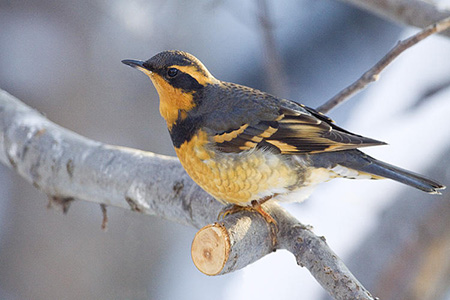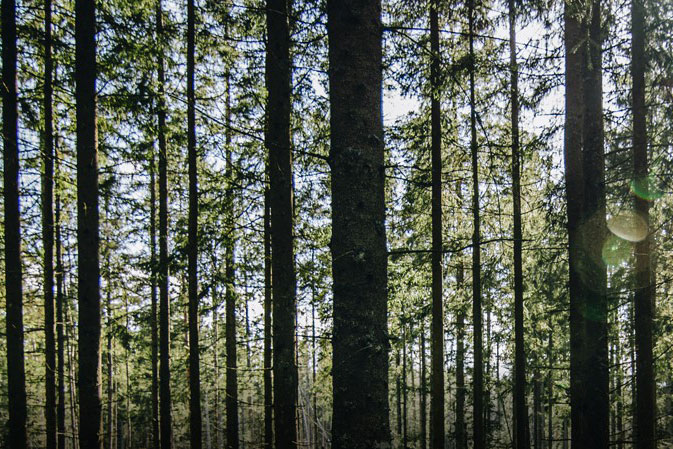The Varied Thrush seems like it would be hard to miss, with its bold orange and black plumage and loud, drawn-out song. But it is actually quite shy and lives mainly in dark, wet forests where it forages on the ground for insects.
Varied Thrush
(Ixoreus naevius)
Habitat Ecology
- The Varied Thrush is generally considered a species of mature and old coniferous forests.1 They are associated with old, unharvested cedar/hemlock and spruce/fir forests,2 lodgepole pine/white spruce,3 Douglas fir/western hemlock/western red alder,4 and black spruce/tamarack.
- They are associated with wet, upland, old forests5 and positively associated with herbs, ferns, and berry-producing shrubs in the understory.6
- The Varied Thrush is often described as a species of dark, wet, and mossy forests.1
- Nests are usually built in the understory vegetation of mature forests (and sometimes second-growth). They may be built on the lower branches of a small conifer, on the ground, in shrubs, or more.1
- While Varied Thrushes do not reuse nests, they tend to build nests near or even on top of old nests.1

Response to Forest Management
- This old forest-associated species is rarely observed in young harvested stands, including retention harvests. It was absent from clearcuts and retention harvests7 and declined in thinned stands.8–10
- Two studies of riparian buffers in the Pacific Northwest found conflicting results. Riparian buffers >30 m supported Varied Thrushes, however it is unclear whether these buffers will support numbers comparable to unharvested forest.11,12
- Low-intensity harvests (e.g., single-tree up to 10 ha openings totaling 30% volume removal within 30 ha blocks) mitigated harvesting effects, particularly in harvests <10 ha.13
- The Varied Thrush showed higher resilience to harvesting in the ESSF dry cool biogeoclimatic zone, where it was common in second-growth stands >7 years (compared with the MS dry cool biogeoclimatic zone, where it was common in second-growth stands >27 years).14
Stand-level Recommendations
- Very small harvesting entries (<10 ha) may reduce negative short-term effects on the Varied Thrush,13 and understory protection may improve habitat value after >7 years,14 in Engelmann spruce-subalpine fir forests.
- Riparian buffers >30–35 m are recommended in old conifer habitats, however these may only provide marginal benefits.11,12
- Large conifers with low foliage density near the top, near water or drainages and on steep slopes, may represent potential song posts and thus be useful as retention patch anchor points. However, this recommendation is derived from research conducted in coastal redwood forests and local studies are suggested.15
Landscape-level Recommendations
- The Varied Thrush’s high sensitivity to harvest and thinning, particularly in lodgepole pine and Douglas fir forests, suggests this species will have its highest densities in older-than-rotation, wet, upland coniferous forests represented on the landscape.
- Old unfragmented forest patches >16 ha, or larger sizes consistent with NRV approaches, are considered to be of the highest value to this species. However, this threshold was determined for coastal redwood forests and may not apply to forests in interior BC or Alberta.16
References
- George, T. L. 2000. Varied Thrush (Ixoreus naevius), version 2.0. in The Birds of North America (Rodewald, P. G., ed.) Cornell Lab of Ornithology, Ithaca, New York, USA. Available online: https://doi.org/10.2173/bna.541
- Hutto, R. L. & Young, J. S. 1999. Habitat relationships of landbirds in the Northern Region, USDA Forest Service. Gen. Tech. Rep. RMRS-GTR-32. U.S. Department of Agriculture, Forest Service, Rocky Mountain Research Station, Ogden, UT. 72 pp. Available online: https://www.fs.fed.us/rm/pubs/rmrs_gtr032.pdf
- Kuhnke, D. H. 1992. Birds in the boreal forest: proceedings of a workshop held March 10-12 in Prince Albert, Saskatchewan. Forestry Canada, Northwest Region, Northern Forestry Centre, Edmonton, AB. 254 pp. Available online: http://www.cfs.nrcan.gc.ca/bookstore_pdfs/23800.pdf
- McGarigal, K. & McComb, W. C. 1995. Relationships between landscape structure and breeding birds in the Oregon Coast Range. Ecological Monographs 65: 235–260. Available online: http://www.jstor.org/stable/2937059
- Anthony, R. G., Green, G. A., Forsman, E. D. & Nelson, S. K. 1996. Avian abundance in riparian zones of three forest types in the Cascade Mountains, Oregon. Wilson Bulletin 108: 280–291. Available online: http://www.science.fau.edu/biology/gawliklab/papers/AnthonyRG-etal1996.pdf
- Carey, A. B., Hardt, M. M., Horton, S. P. & Biswell, B. L. 1991. Spring Bird Communities in the Oregon Coast Range. Pages 123–142 in Wildlife and Vegetation of Unmanaged Douglas-Fir Forests (Ruggiero, L. F., Aubry, K. B., Carey, A. B. & Huff, M. H., eds.) 123–142. General Technical Report PNW-GTR-285. USDA Forest Service, Pacific Northwest Research Station, Olympia, WA. Available online: http://agris.fao.org/agris-search/search.do?recordID=US9162241
- Lance, A. N. & Phinney, M. 2001. Bird responses to partial retention timber harvesting in central interior British Columbia. Forest Ecology and Management 142: 267–280.
- Hayes, J. P., Weikel, J. M. & Huso, M. M. P. 2003. Response of birds to thinning young Douglas-fir forests. Ecological Applications 13: 1222–1232. Available online: http://dx.doi.org/10.1890/02-5068
- Hagar, J. C., Howlin, S. & Ganio, L. 2004. Short-term response of songbirds to experimental thinning of young Douglas-fir forests in the Oregon Cascades. Forest Ecology and Management 199: 333–347.
- Bayne, E. M. & Nielsen, B. 2011. Temporal trends in bird abundance in response to thinning of lodgepole pine (Pinus contorta). Canadian Journal of Forest Research 41: 1917–1927. Available online: http://www.nrcresearchpress.com/doi/10.1139/x11-113#.Wftr0NCnFzB
- Pearson, S. F., Giovanini, J., Jones, J. E. & Kroll, A. J. 2015. Breeding bird community continues to colonize riparian buffers ten years after harvest. PLoS ONE 10: e0143241. Available online: https://doi.org/10.1371/journal.pone.0143241
- Hagar, J. C. 1999. Influence of riparian buffer width on bird assemblages in western Oregon. The Journal of Wildlife Management 63: 484–496. Available online: http://www.jstor.org/stable/3802633
- Luepold, S. H. B., Hodgman, T. P., McNulty, S. A., Cohen, J. & Foss, C. R. 2015. Habitat selection, nest survival, and nest predators of Rusty Blackbirds in northern New England, USA. The Condor 117: 609–623. Available online: http://www.bioone.org/doi/10.1650/CONDOR-14-215.1
- Stuart-Smith, A. K., Hayes, J. P. & Schieck, J. 2006. The influence of wildfire, logging and residual tree density on bird communities in the northern Rocky Mountains. Forest Ecology and Management 231: 1–17.
- Beck, M. J. & George, T. L. 2000. Song post and foraging site characteristics of breeding Varied Thrushes in northwestern California. The Condor 102: 93. Available online: https://doi.org/10.1650/0010-5422(2000)102[0093:SPAFSC]2.0.CO;2
- Brand, L. A. & George, T. L. 2001. Response of passerine birds to forest edge in coast redwood fragments. The Auk 118: 678–686. Available online: http://www.jstor.org/stable/4089929








